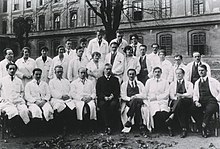Josef Gerstmann
Josef Gerstmann (born July 17, 1887 in Lemberg , † March 23, 1969 in New York ) was an Austrian neurologist , psychiatrist and neuropathologist.


medical team in Vienna in 1927.
Josef Gerstmann in the first row, fourth from the right, next to the boss.
Life
Gerstmann studied medicine in Vienna from 1906 to 1912 and obtained his doctorate in 1912. He served as a medical officer in World War I and received high honors for bravery. He then worked at the psychiatric-neurological clinic until he succeeded Emil Redlich (1866–1930) as head of the Maria-Theresien-Schlössel mental hospital in Vienna in 1930 . There he had already completed his habilitation in 1921 and received the title of professor in 1929. As a Jew, he fled to the United States in 1938 after losing his teaching license at the University of Vienna and his position as chief physician , where he initially worked as a consultant at Springfield State Hospital in Sykesville, Maryland , exercised. After a stopover from 1940-41 at the Saint Elizabeth Hospital in Washington, DC, he was from 1941 to 1945 "Research Associate" at the New York Neurological Institute and a neuropsychiatrist at the Goldwater Memorial Hospital and (until 1949) at the Postgraduate Hospital in New York. In addition, he worked in a private practice in New York after receiving his American medical certification. He never again achieved a managerial position at a hospital and after the Second World War he had unpleasant arguments with the Austrian state because of his property confiscated by the Nazis.
He was a member of the American Neurological Academy and the Society of Neurology and Psychiatry in Rosario , Argentina .
Gerstmann described the finger diagnosis in more detail in 1924, in 1927 for the first time the syndrome that was later named after him ( Gerstmann syndrome ) and in 1928 and in more detail in 1936 the one later named after him and the Austrian and Austrian-US-American neurologists and psychiatrists and neuropathologists Ernst Sträussler and Isaak M Disease named Scheinker ( Gerstmann-Sträussler-Scheinker syndrome ). He is also known for the Gerstmann test, a further development of the Unterberger pedal test .
literature
- Josef Gerstmann. In: Judith Bauer-Merinsky: The effects of the annexation of Austria by the German Reich on the medical faculty of the University of Vienna in 1938: Biographies of dismissed professors and lecturers. ( Memento of November 9, 2014 in the Internet Archive ) (PDF; 182 kB). Dissertation. Vienna 1980, pp. 71-73b.
Web links
- Josef GERSTMANN (1887–1969): Expelled 1938 (36). In: VAN SWIETEN blog of April 29, 2008
Individual evidence
- ^ LA Zeidman, MG Ziller, M. Shevell: Gerstmann, Sträussler, and Scheinker: the persecution of the men behind the syndrome . In: Neurology . tape 83 , 2014, pp. 272-277 .
- ^ LA Zeidman, MG Ziller, M. Shevell: “With a smile through tears”: The uprooted career of the man behind Gerstmann syndrome . In: J Hist Neurosci . tape 24 , 2015, p. 148-172 .
- ↑ J. Gerstmann: Fingeragnosie: a circumscribed disorder of orientation on one's own body . In: Vienna Klin Wchschr . tape 37 , 1924, pp. 1010-1012 .
- ↑ J. Gerstmann: Fingeragnosie and isolated agraphia, a new syndrome. In: Z ges Neurol Psychiatrie . tape 108 , 1927, pp. 152-177 .
- ↑ J. Gerstmann: About a not yet described reflex phenomenon in a disease of the cerebellar system. In: Wien Med Wchschr . tape 78 , 1928, pp. 906-908 .
- ↑ J. Gerstmann, E. Sträussler, I. Scheinker: About a peculiar hereditary-familial disease of the central nervous system. At the same time a contribution to the question of premature local aging . In: Z ges Neurol Psychiatrie . tape 154 , 1936, pp. 736-762 .
| personal data | |
|---|---|
| SURNAME | Gerstmann, Josef |
| BRIEF DESCRIPTION | Austrian neurologist |
| DATE OF BIRTH | July 17, 1887 |
| PLACE OF BIRTH | Lviv |
| DATE OF DEATH | March 23, 1969 |
| Place of death | new York |